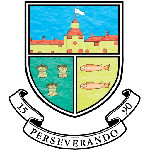Mathematics
| Mr S Robinson (Head of Team) | srobinson@conyers.org.uk | Mr J Downs | jdowns@conyers.org.uk |
| Mr K Anderson | kanderson@conyers.org.uk | Mrs K Gray | kgray@conyers.org.uk |
| Miss L Allanson | lallanson@conyers.org.uk | Mr M Black | mblack@conyers.org.uk |
| Mr P Dixon | pdixon@conyers.org.uk | Mr A Pach | apach@conyers.org.uk |
| Mr M Taylor | mtaylor@conyers.org.uk | Mx A Taylor | ataylor@conyers.org.uk |
| Mrs J White | jwhite@conyers.org.uk |
Key Stage 3 Curriculum Map
Curriculum Intent
To engage and enthuse learners in studying mathematics whilst embedding in them the fundamental and transferable skills which allow for the development of resilience and problem solving abilities through their application in wide ranging situations and contexts.
Key Knowledge and Skills
Year 7
Use positive integer powers and associated real roots
Apply the four operations with decimal numbers
Write a quantity as a fraction or percentage of another
Add, subtract, multiply and divide with fractions and mixed numbers
Check calculations using approximation, estimation or inverse operations
Simplify and manipulate expressions by collecting like terms and multiplying a single term over a bracket
Substitute numbers into formulae
Solve linear equations in one unknown
Calculate surface area of cubes and cuboids
Understand and use geometric notation for labelling angles, lengths, equal lengths and parallel lines
Year 8
Apply the four operations with negative numbers
Convert numbers into standard form and vice versa
Convert between terminating decimals and fractions
Factorise an expression by taking out common factors
Find and use the nth term for a linear sequence
Solve linear equations with unknowns on both sides
Plot and interpret graphs of linear functions
Use multiplicative reasoning to interpret percentage change
Understand and use lines parallel to the axes, y = x and y = -x
Calculate theoretical probabilities for single events
Year 9
Apply the formulae for circumference and area of a circle
Change the subject of a formula when two steps are required
Solve problems involving percentage change, including original value problems
Find a relevant multiplier when solving problems involving proportion
Apply the multiplication, division and power laws of indices
Sequence Discussion
Year 7
The year begins by practising written calculation skills. We assess students to ensure KS2 data reflects their initial ability too – some slight adaptations are made to streaming at this point. The first term focuses on Number, Geometry and Data skills. Basic algebraic techniques are formally introduced in HT3 and revisited half termly up until HT5. The scheme is written to provide a variety of topics and activities throughout the year.
The assessment at the end of year 7 tests students on content from the Year 7 SoW as well as the KS2 programme of study.
Year 8
The Year 8 sequence of topics is broadly the same as that used in Year 7. We assess students towards the end of the first half term – again, some slight adaptations are made to streaming at this point. Content in Year 8 is in most cases deepening learning from Year 7, however, some brand new topics are also introduced (calculations involving circles and linear and quadratic graphing in HT4).
The assessment at the end of year 8 tests students on content from the Year 7 and 8 SoW as well as the KS2 programme of study.
Year 9
There is greater emphasis on algebraic techniques in Year 9. All the basic manipulation of expressions and equations are covered in Year 7 and 8 so we now look to apply it in more difficult situations (SDT graphs in HT2, inequalities in HT3, new graphs in HT4 and simultaneous equations in HT5). Other brand new topics include formal constructions and loci (HT1), Pythagoras’ Theorem, conjecturing and proof (HT3) and the use of bounds (HT4).
The assessment at the end of year 9 tests students on content from all KS3 SoW.
Years 7, 8 & 9
Throughout each year, we use ‘skills based starters and homework’ to ensure regular practise of fundamental skills and techniques is taking place. A set of 10 skills is chosen each half term and these are tested by questions which are repeated weekly but with minor tweaks. The idea is to focus on cementing the building blocks of a mathematician whilst leaving more time in lessons to introduce new concepts without having to reteach the skills required to access it. Students keep a record of their progress electronically and the teacher assesses this at the end of each half term.
Year 7
Half Term 1
Numbers and the number system
Visualising and constructing shapes
Investigating properties of shapes
Angles
Half Term 2
Calculating
Counting and comparing – fractions decimals and negatives
Measuring data
Half Term 3
Calculating 2: calculating and order of operations
Algebraic proficiency
Solving equations and inequalities
Half Term 4
Exploring fractions, decimals & percentages
Understanding risk
Pattern searching
Half Term 5
Presentation of data
Calculating fractions, decimals and percentages
Calculating space
Proportional reasoning
Half Term 6
Measuring space
Calculating space
Mathematical movement
Year 8
Half Term 1
Exploring fractions, decimals and percentages
Calculating fractions, decimals & percentages 1 & 2
Measuring data 1
Half Term 2
Measuring data 2
Presentation of data
Checking, approximating and estimating
Numbers and the number system
Half Term 3
Calculating
Algebraic proficiency: tinkering
Solving equations and inequalities
Half Term 4
Proportional reasoning
Visualising and constructing
Half Term 5
Numbers and the number system 2
Pattern searching
Algebraic proficiency: visualising
Half Term 6
Understanding risk
Investigating angles
Calculating space
Year 9
Half Term 1
Calculating
Algebraic proficiency: tinkering
Solving equations and inequalities
Half Term 2
Investigating quadrilaterals
Visualising and constructing
Proportional reasoning
Algebraic proficiency: visualising
Half Term 3
Pattern searching
Algebraic proficiency: visualising 2
Half Term 4
Solving equations and inequalities
Measuring data 2
Presentation of data
Half Term 5
Calculating fractions, decimals and percentages
Understanding risk
Calculating space
Half Term 6
Calculating space
Conjecturing
Calculating
Formal symmetries and reflections

